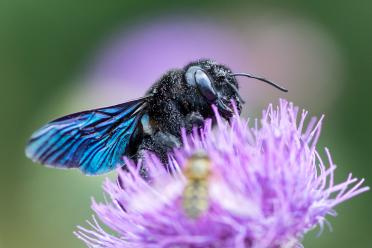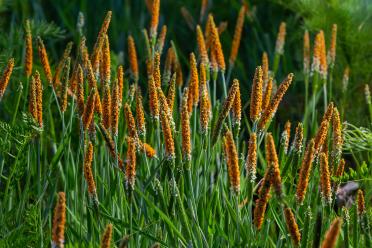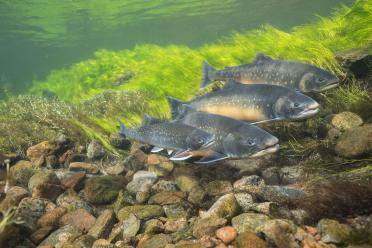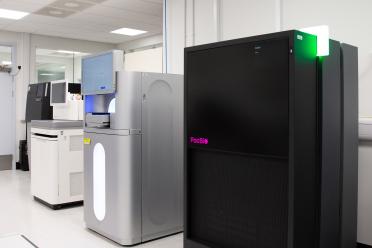The fish, the fungus, the grass, the bee - and the brassica
Approximately one fifth of the 200,000 eukaryotic species found in Europe are at risk of disappearing.
As we live through the planet’s sixth mass extinction event, the Earlham Institute has joined the European Reference Genome Atlas (ERGA), a ground-breaking network of researchers across Europe documenting our vanishing lifeforms.
ERGA is a continent-wide response to the threat to diversity, collecting and sequencing the genomes of all European eukaryotes to better understand them for the future. It is part of the wider Earth Biogenome Project.
Supported by BBSRC strategic funds, several groups of researchers at the Earlham Institute have taken part, leading to new reference genomes for species from Iceland, Malta, the Czech Republic, the Azores, and here in the United Kingdom.
These include Dr Wilfried Haerty, whose group is piecing together the genome of the violet carpenter bee, and Dr Karim Gharbi, who oversees the projects to sequence the Arctic char and the brassica Cardamine caldeirarum.
“We wanted to use our expertise and infrastructure in biodiversity genomics to help demonstrate the feasibility of coordinating the assembly of reference-quality genomes for multiple species from across Europe,” Dr Gharbi says.
“We were particularly interested in capturing a diverse set of genomes across the European tree of life.
“Most existing technologies and algorithms for reference assembly are optimised for human or human-like genomes. Cataloguing the sheer diversity of genomes on a continental scale adds a huge level of complexity, which requires a flexible and collaborative approach.”
Professor Neil Hall’s group sequenced the genome of the fungus Spongipellis delectans, while Professor Anthony Hall’s group worked on orange foxtail grass.

Xylocopa violacea, the violet carpenter bee
These five genomes sequenced by the Institute are part of the ERGA Pilot Project.
ERGA researchers are developing the first infrastructure for coordinated and distributed reference genome production, and testing it on 98 European eukaryotic species, from sample providers across 33 European countries.
Meeting this goal requires many individual regional projects to coordinate. The Earlham Institute is also involved with Darwin Tree of Life (DTOL), the project to sequence the UK’s 70,000 eukaryotes.
In both initiatives, the Institute contributed its unique expertise in working with non-model organisms and the integration of wet-lab techniques and bioinformatics across the Institute’s Faculty and National Bioscience Research Infrastructure (NBRI) in Transformative Genomics.
Dr David Swarbreck, Head of Core Bioinformatics, had team members working on four of the ERGA pilot species.
“These diverse organisms presented challenges including high levels of heterochromatin, polyploidy, and large genome size,” he says.
“They have provided excellent candidate species to explore and refine our approaches for assembling and annotating genomes.”

[ERGA] allows research organisations like the Earlham Institute – primarily working with technology and data - to collaborate with scientists such as ecologists working in the field, and do so in a really natural and open way.

Dr Seanna McTaggart, Programme Manager at the Earlham Institute and ERGA representative

Alopecurus aequalis, the Orange Foxtail
Dr Seanna McTaggart is Programme Manager at the Earlham Institute and ERGA representative.
“ERGA was designed to be collaborative and interdisciplinary,” she explains, “allowing scientists with different specialities from all over Europe to work together easily.”
She says humanity needs to act fast to generate high-quality complete genome resources, and ERGA is intended to accelerate that process.
“The ERGA network is inclusive and transparent, allowing us to share information and knowledge,” she adds.
“It allows research organisations like the Earlham Institute – primarily working with technology and data - to collaborate with scientists such as ecologists working in the field, and do so in a really natural and open way.”
Reference genomes are a high-quality and powerful resource for complete understanding of a species.
ERGA contributes to the Earth BioGenome Project (EBP). This ambitious piece of work, inspired by the Human Genome Project, aims to sequence all eukaryotic life on earth - generating reference quality genome assemblies for approximately 1.9 million described eukaryotes.

These diverse organisms presented challenges including high levels of heterochromatin, polyploidy, and large genome size. They have provided excellent candidate species to explore and refine our approaches for assembling and annotating genomes.

Dr David Swarbreck, Head of Core Bioinformatics at the Earlham Institute

Salvelinus alpinus, the Arctic Char
Zophonías O. Jónsson, Professor of Molecular Genetics at the University of Iceland, is ERGA sample ambassador for the Arctic char. He describes it as a species which is highly important, both for research purposes and aquaculture.
“A high-quality reference genome for the Arctic char will be very useful, both in academia and in the commercial world. This fish is an important food source as well as a non-model organism and a biologically interesting species.”
He says the process of sequencing and analysis through Earlham ran very smoothly.
“Dr Gharbi, Dr McTaggart, and the rest of the Earlham team were a true pleasure to work with - highly efficient, scientifically on top of things and excellent at communicating and problem solving.”
And Dr Dana MacGregor, Weed Molecular Biologist at Rothamsted Research, contributed plant material for orange foxtail.
She says: “We have been studying Alopecurus aequalis (orange foxtail) and Alopecurus myosuroides (black-grass), which are the most problematic weeds for wheat cultivation in China and the UK respectively.
“While we knew both species survive herbicide application, our understanding of how they accomplish this feat was limited.
“Early in our research programme, we encountered a scientific roadblock. Despite successfully generating ‘omics data, our inability to access a complete and annotated genome for both species hindered our ability to effectively interpret it.
“Collaborating with the Earlham Institute on the ERGA Pilot project, we have generated a reference-grade genome for orange foxtail. This resource allows us to overcome our knowledge barriers and begin asking the questions that are crucial to understanding how these weeds survive.
“Our new genome not only facilitates our research but - when made public - will empower other researchers to explore other molecular aspects of this insidious weed and together we will generate knowledge that results in effective and sustainable weed control.”

The sequencing labs at the Earlham Institute house the latest technology platforms such as the PacBio Revio, and illumina NovaSeq X Plus.

We wanted to use our expertise and infrastructure in biodiversity genomics to help demonstrate the feasibility of coordinating the assembly of reference-quality genomes for multiple species from across Europe.

Dr Karim Gharbi, Head of Technical Genomics at the Earlham Institute
ERGA’s goal is to create a collaborative and interdisciplinary network of scientists across Europe and associated countries. It is decentralised, involving diverse existing support options: sequencing centres, such as the Earlham Institute, biobanks, and museum collections.
It also delivers impact by offering training and knowledge transfer through conferences, webinars, and hands-on training workshop opportunities.
Find out more about ERGA at www.erga-biodiversity.eu and about the Earlham Institute’s projects and research here.